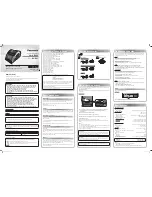
device to the water ground of the boat to help avoid the
interference.
Connecting a VHF Antenna
1
Mount the VHF antenna (sold separately) according to the
installation instructions provided with the antenna.
NOTE:
You can purchase a VHF extension cable. Go to
or contact your Garmin dealer.
2
Connect the VHF antenna cable to the port on the VHF
115/215 AIS device.
NMEA 2000 Device Connections
NOTICE
If you are installing a NMEA 2000 power cable, you must
connect it to the boat ignition switch or through another in-line
switch. NMEA 2000 devices will drain your battery if the NMEA
2000 power cable is connected to the battery directly.
If you are unfamiliar with NMEA 2000, you should read the
“NMEA 2000 Network Fundamentals” chapter of the
Technical
Reference for NMEA 2000 Products
. Go to
.
Item
Description
Compatible NMEA 2000 chartplotter or other device
VHF 115/215 AIS device
Ignition or in-line switch
NMEA 2000 power cable
NMEA 2000 drop cable
12 Vdc power source
NMEA 2000 terminator or backbone cable
NMEA 2000 T-connector
NMEA 2000 terminator or backbone cable
Connecting to a Remote GPS Antenna
This device includes an internal GPS antenna. If your mounting
location does not provide good GPS reception, you may install a
remote GPS antenna with a female BNC connector (not
included), and connect it to the device.
NOTE:
If you connected this device to a NMEA 2000 with a
GPS antenna, you can use that antenna as a GPS source
instead of installing a remote GPS antenna (
).
1
Follow the instructions provided with the external GPS
antenna to install it on your boat correctly.
2
Route the GPS antenna cable to the back of the VHF
115/215 AIS device, away from sources of electrical
interference.
3
Connect the GPS antenna cable to the BNC connector on the
wiring harness on the VHF 115/215 AIS device.
NMEA 0183 Device Connections
This diagram illustrates two-way connections for both sending
and receiving data. You can also use this diagram for one-way
communication. To receive information from a NMEA 0183
device, refer to items , , , , and when connecting the
Garmin device. To transmit information to a NMEA 0183 device,
refer to items , , , , and when connecting the Garmin
device.
Item
Description
Power source
Power cable
NMEA 0183 device
NMEA 0183 cable
Item
Garmin Wire
Function
Garmin Wire
Color
NMEA 0183
Device Wire
Function
Power
Red
Power
Power ground
Black
Power ground
Data ground
Black
Data ground
Rx/A (In +)
White/orange
Tx/A (Out +)
Rx/B (In -)
White
Tx/B (Out -)
Tx/A (Out +)
Gray
Rx/A (In +)
Tx/B (Out -)
Pink
Rx/B (In -)
If the NMEA 0183 device has only one input (receive, Rx) wire
(no A, B, +, or -), you must leave the pink wire unconnected.
If the NMEA 0183 device has only one output (transmit, Tx) wire
(no A, B, +, or -), you must connect the white/orange wire to
ground.
Connecting to a Hailer Horn or PA Speaker
You can connect a VHF 215 AIS radio to a hailer horn or public
address (PA) speaker (not included) to use the microphone or
the handset to make announcements.
NOTE:
The VHF 115 radio cannot be connected to a hailer
horn.
1
If necessary, mount the hailer horn or PA speaker according
to the installation instructions provided with the device.
NOTE:
To avoid feedback, you should mount the hailer horn
or PA speaker at least 3 m (10 ft) away from, and facing
away from, the microphone or handset.
2
Route or extend the wire from the hailer horn or PA speaker
to the radio.
3
Connect the white wire on the radio wiring harness to the
positive (+) wire from the hailer horn or PA speaker.
4
Connect the green wire on the radio wiring harness to the
negative (-) wire from the hailer horn or PA speaker.
5
Cover the connections with a waterproof tape or heat-shrink
tubing.
Connecting to an External Speaker
You can connect the radio to an external speaker (not included)
to hear the radio at a remote location.
3






















